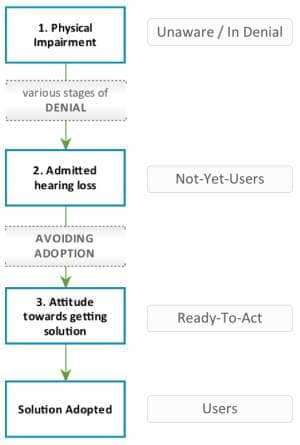The hearing care field can use the Internet to convert not-yet-users into clients
There are many opinions, recommendations, guidelines, and tools regarding online marketing. Whereas once upon a time, a Web site would suffice, today you need much more.
The things you can do with online marketing seem endless and the complexity is great, but so is the associated fear of the unknown—of making a mistake. You may hear that the Internet is not forgiving, that once posted, your information is there indefinitely. You may hear that the Internet is not visited by your demographic, so why bother? You may hear that traditional marketing is the ultimate way to go.
This article addresses some of these issues and attempts to shed light on the fact that, even without much Internet experience, you too can use online marketing as an important facet in growing your practice.
The traditional marketing approach is interruptive; we have a message and a solution and we try to interject our message in our community to clients and non-clients alike. In most cases, our key objective is to brand our clinic.
However, the unfortunate reality is that most of our prospective patients focus on product, not clinic differentiation. Thus, our branding message—the thing that differentiates each of us from the competition—is lost on the client. Additionally, our message is often wrapped in platitudes that don’t effectively communicate what we need to convey, so the potential client completely misses our call to action. Word-of-mouth referral programs, which are usually handled in-clinic and rely on referral benefits and incentives, are more powerful, but most of us would agree that the best word-of-mouth advertising is spontaneous and voluntary, not elicited/solicited.
So the questions remain:
- How can we get more patients into our clinic?
- How do we effectively differentiate and communicate this effectively?
- How do we shift from interruptive to on-demand marketing?
According to MarkeTrak VIII1:
- 35 million people in the US admit to a hearing loss and are aware of some problem with their hearing.
- However, only 25% of them are using hearing aids.
- The rest (75%) don’t use hearing aids. It should be acknowledged that a large percentage of these people do not yet have a hearing loss significant enough (in their view) to warrant amplification. However, they still fall into the category of what might be called not-yet-users (NYUs)—we hope they will be users at some point if/when their self-perceived hearing disability reaches a point where it significantly affects their lives in any number of physical, social, financial, or psychosocial ways.
- I would propose that a small portion of the NYUs (perhaps about 1-2 million or 4-8%) are currently looking for a clinic or hearing help. This is a very specific group of people, which I’ll refer to as ready-to-act (RTA), and a subset of these RTAs actually become what the industry calls “first-time users” (fewer than 500,000 people in the United States during 2011 when disregarding VA activity).
- There are also others who, although they have hearing loss, are unaware of it or won’t admit it. These are more difficult to quantify.
What’s Our Marketing Strategy?
Most advertising by hearing care professionals is spread to everybody in the local area, hoping that the right people—that relatively small, specific population of RTAs—are reached. Within any given population of people, the RTAs represent less than 4% to 8% of those with hearing loss, and since not everybody has hearing loss, it may be closer to 0.3% from the entire population, depending on the area. Trying to reach this small group by casting your message to every single person in your area is called “bullet-spray” or “shotgun” marketing.
Not only is shotgun marketing expensive, but it can actually have the unintended consequence of scaring people away when they see too many competing advertising claims based on clinic differentiation and special offers and then conclude that these offices are “the same.”
So How Can We Do Things Better?

Table 1. Estimates, by age groups, of the total hearing loss (total HL) population, number of hearing aid users, not-yet-users (NYU), as well as estimates of NYUs in age catagories and online. Data extrapolated from Kochkin’s MarkeTrak VIII,1 and Generations 2010 from Pew Internet (Kathryn Zickuhr).2
First, we can focus more on the target. Focus your marketing on reaching mainly the NYUs and, even better, the RTAs. The problem is there are no lists that contain only the people who are aware of their loss and who don’t have hearing aids.
So how can we reach consumers with a targeted approach? There is one key method: on-demand marketing, also called inbound marketing. They look for us when they are ready. Does this mean Yellow Pages? That’s part of it, but certainly not all of it. People are not only looking for dispensing offices, they are searching for health information. A good dispensing professional needs to be part of this search.
And, along with community outreach efforts, the best place to do that is online. When consumers are ready, they will look for information on hearing loss, and that’s when they will find the well-positioned dispensing professional.
The second way to improve our marketing is trying to motivate more of the NYUs to get amplification. Of course, our industry and related professional organizations have been trying to do this for ages. However, for an individual dispensing office, it can be difficult addressing problems related to auditory deprivation and the disability of hearing loss without being seen as “trying to sell them something.”
In summary, we need highly targeted, low-cost, and efficient marketing. For this, our message needs to be delivered on-demand, and the best way to do that is online and in community outreach programs. The second thing we need to do is to motivate NYUs to become RTAs.
Is this within the power of individual dispensing professionals, or does this fall into the realm of a national awareness campaign, something bigger than can be achieved at the individual clinic level? A united front presenting common interests and non-conflicting information, as opposed to squabbling over competitive differences, is in our best interests. Our common goal is to help more people with hearing loss and make hearing aid use more mainstream—not just to obtain more market share in our locales. By presenting a consistent message to the consumer, using common materials from organizations, such as the Better Hearing Institute, we will all benefit from more market share.
Targeting and Motivation
To understand motivation and targeting, we need to understand consumers and their online activity. Research suggests that there are 25.8 million NYUs in the United States,1 and 67%—or 17.3 million—of them are online (Table 1).2 Additionally, research suggests that this number is growing all the time: a 117% increase between 2004 and 2009 in Internet usage, rivaling time spent watching TV.
When they are online, they are looking for a variety of things. Among the top-10 online activities, we see consumers looking for health information, news, and product information and ratings. The NYU will expect to see this information when researching hearing loss, hearing aids, and hearing care providers. In many cases, scant information exists from “neutral” sources.
If we look at the demographic and the research on how various age groups use the Internet, we can see that a lot of online NYUs—about 85% or 14 million—are looking for health information. When we consider online activity and look at specific searches, Google data suggest that over 1 million searches are done each month on terms related to hearing. Likewise, the hearing loss population is growing at 160% (about one and a half times) faster than the general population.
This presents a golden opportunity to use online tools to increase hearing health awareness of NYUs, converting them into RTAs and hearing aid users.
Current Online Marketing

Figure 1. The stages involved in accepting hearing loss and adopting a hearing solution.
Although it is not for lack of trying, the potential number of NYUs being transformed into RTAs and entering the traditional hearing care professional channel is not impressive. There is a lot of online information about hearing loss and hearing aids, including sites from dispensing offices, manufacturers, non-profits, consumer and professional organizations, as well as forums and online lead generators. However, according to MarkeTrak VIII,1 current Internet information doesn’t contribute significantly to the NYU’s decision to adopt hearing aids. In this study, only 0.7% of the first-time users pointed out Internet information as an influencer in their decision to go to a clinic and get hearing aids.
If we apply that to 2010 unit sales, this amounts to only about 4,000 people. And, if we compare this to the 14 million who are online searching for information, this means very few people find enough motivation online to search for and ultimately purchase hearing aids from that dispensing office. That is about a 0.03% conversion rate.
This suggests that, for whatever reason, the NYUs are not motivated or inspired by the information they find online to take appropriate action and call a clinic. We need to remember that most of the NYUs are not ready to go for hearing aids for numerous reasons, including all the various issues detailed by MarkeTrak from “hearing loss not bad enough yet” to financial concerns and stigma issues.
We’ve all met these people at our clinics. They are the “need hearing aids but don’t want them” type. The predominant approach of current Web sites is to offer these people information top-down—or from the site to the visitor—hoping that the consumer will decide to act and make an appointment. However, according to the evidence, that’s a jump most of the visitors don’t make. Either they are not yet in the mind-frame to choose a clinic, or they are being put off by the information they find. Or both.
Therefore, industry wide, our online marketing should give visitors more than just self-advertising information; it should motivate them to find a dispensing clinic/office and get started on a solution for their hearing loss. It should help them go beyond the obstacles—the financial, psychosocial, and perceived product limitations—that stop them from adopting hearing aids.
And that’s where our industry’s current online marketing appears to fall short. In order to understand why this happens, we need to understand the hearing aid adoption process and its obstacles.
Adoption Process
The hearing aid adoption process, as analyzed by Sergei Kochkin in MarkeTrak VII,3 suggests that there are four major stages (physical impairment, admitted hearing loss, attitude toward getting a solution, and adopting that solution), and two sets of obstacles (denial between Stages 1 and 2, and avoidance between Stages 2 and 3), as shown in Figure 1. Particularly, avoidance is interesting as it takes an average of 8 years, according to this study, to move from Stage 2 to 3.
Looking at this in more detail, denial is the psychological resistance to admitting physical impairment. Most of the time, consumers overcome this obstacle with the help of their friends and families, by subjective testing (identifying symptoms of hearing loss in their life) and objective testing. Awareness and education help with all these positive influences (shown here by the green arrows). However, even in early stages, we find a secondary obstacle to objective testing. Since objective testing happens in the clinic, the person needs to overcome their mistrust of professionals. Because the clinicians also sell hearing aids, they are seen as having a direct interest in producing a test showing hearing loss.
This comes up again in the next phase—after hearing loss is admitted—as an obstacle to adoption. Mistrust can be overcome through an additional positive influence: success stories and positive word-of-mouth from existing hearing aid users and clinic patients. Avoiding adoption is a huge barrier for the NYU and includes perceived stigma, financial obstacles, product misperceptions, negative service perception, physicians’ attitudes toward hearing loss, and fear of a need for “medical intervention.”
So how do we overcome these barriers? The MarkeTrak data suggest several solutions: earlier adoption of hearing aids (particularly by working-age people) would reduce the stigma; financial incentive would help break down the price barrier; less generic information would create a more accurate product perception; and unbiased info in a nonthreatening environment would improve the service perception and alleviate fear. For example:
- Positive word of mouth and success stories help reinforce service and product perception. In terms of testimonials, lots of clinics feature them on their Web sites. The problem is they are generally viewed as subjective, one-sided, and obviously in favor of the clinic. It’s pretty rare to find a testimonial that offers a frank appraisal in which, for example, a patient mentions wrestling with a particular listening situation. Video, in particular, can lend a lot of authenticity to testimonials and capture the consumers’ true feelings about the patient journey.
- Positive product reviews improve product perception and help assuage fear. Even negative reviews provide a more believable backdrop to the positive ones, and are generally taken “with a grain of salt” in light of overwhelming positive reviews.
- Peer-to-peer information is generally perceived as unbiased, which has a higher impact than top-down information. Family and friends’ recommendations, the most effective motivator for adoption (as shown in MarkeTrak), are just that: peer-to-peer information.
- Professional education and adherence to best practice protocols improves the quality of the services offered by dispensing professionals. This generates positive word of mouth peer-to-peer information and affects the “perceived value” of hearing solutions. People are generally willing to pay a higher price when they perceive a higher value via enhanced service.
- When we educate physicians on hearing loss and appropriate solutions, they also can help with referrals and recommendations.
Once avoidance has been overcome, the NYU has a more positive attitude toward finding a solution—and a clinic/office. Now it’s just a matter of steering them in your direction.
This is the part where your traditional marketing acts. One of the reasons traditional marketing is not very efficient is because not many NYUs are brought to Stage 3. Once the conversion is more effective, from Stages 1 and 2 to this third stage, any general marketing you do will likely have a higher return. Otherwise, your marketing is reaching people who are not ready to hear your message.
Increasing Hearing Instrument Adoption Rates
So what do we need to do to increase adoption? Virtually any way of helping NYUs realize and understand their hearing problem would help. To do this, we need to address denial and avoidance. Let’s look at some broad solutions to specific obstacles taken from Sergei Kochkin’s MarkeTrak VII data:
Stigma. “While [less conspicuous products] partially solve external stigma (what other people see), it does not solve the individual’s internal stigma (what people with hearing loss feel about themselves). Until younger people (versus the average age of 70 for first-time users) begin using hearing aids, the stigma of hearing aid use will remain; in short, the average age of first-time users must be reduced in the next generation.”3
Solutions: Awareness, consumer education, professional education, improving the image of hearing aids, using data that links hearing and income status.
Mistrust. “One in four (24%) indicated that lack of trust of at least one of these professionals [physicians, audiologists, dispensers] impacted their decision not to purchase, 13% “definite” and 11% “somewhat.” There were only very small differences in perceived trustworthiness of these three professionals. In other words, if they mistrusted one profession, they mistrusted all.”3
Solutions: Patient stories of success (and frank appraisals) in videos, positive word of mouth, clinic/clinician reviews.
Negative word of mouth. “Myths about hearing aid technology can be overcome with educational efforts to both the potential end-user and the medical community. Among this sample of non-adopters, 19% indicated that the experiences of other hearing aid owners influenced their decision not to get hearing aids; that’s 4.4 million people affected by negative word-of-mouth reports. While tremendous advances have been made in hearing aid technology in the past decade, attitudes cannot change dramatically without a corresponding improvement in the current consumer’s journey.”3
Solutions: Patient success stories/videos, reviews, setting expectations, improved consumer experience through best practices.
Underestimating the problem. “Focus groups with non-adapters have shown that people with hearing loss tend to underestimate the severity of their loss. To counter this misperception, educational efforts could be targeted at significant others, including medical professionals to assist them in communicating more accurate perceptions of the degree of hearing loss to the person with the loss.”3
Solutions: Better and more coordinated physician outreach, peer-to-peer communication, success stories, objective tests.
Misinformation. “Some people do not try hearing aids because they have been given false information related to hearing aid candidacy. Specifically, people with high-frequency or low-frequency hearing loss, nerve damage (ie, sensorineural hearing loss), or unilateral hearing loss were often told they were not candidates for hearing aids. Public awareness efforts to counter these myths could move more people toward considering hearing aids.”3
Solutions: Awareness, consumer and professional education, qualified case-specific information before reaching the clinic, more consistent information about hearing aids.
Price. “Three out of four (76%) respondents mentioned financial constraints as a barrier to hearing aid adoption…64% indicated they cannot afford hearing aids, while nearly half (49%) indicated it is a definite reason why they don’t use hearing aids. More than half (52%) complained that they are expensive to maintain while four out of ten (45%) indicated they are not worth the expense. Only one out of ten (11%) indicated that they use a less expensive device to compensate for their hearing loss”3
Solutions: Higher perceived value of hearing aids through use of best practices protocols, education on financing options, third-party coverage, and tax benefits.
Misperception of product. “Half of those in the most serious hearing loss segment hold at least one negative attitude toward hearing aids. In rank order the most commonly cited negative beliefs are: They are unable to perform in noise, they cannot restore hearing to normal (like glasses), they whistle and feedback, they do not work in crowds, they amplify unwanted background noise (eg, the refrigerator), and they are a hassle.”3
Solutions: Better information on hearing aids, product reviews, success stories.
Tinnitus. “About four people in ten who have a hearing loss indicated that their tinnitus was either ‘definitely’ or ‘somewhat’ a reason for non-adoption of hearing aids. While the efficacy of hearing aids in treating hearing loss is well established, the impact of amplification on people with concurrent tinnitus and hearing loss needs to be investigated further and reported to the public and the medical community.”3
Solutions: Better education on tinnitus and hearing aids, success stories for tinnitus with loss.
Part 2 of this article will focus on how to be effective and increase hearing aid sales using key online tools like Facebook, Twitter, Tumblr, YouTube, directories, and other online vehicles.
References
- Kochkin S. MarkeTrak VIII: 25-year trends in the hearing health market. Hearing Review. 2009;16(11):12-31.
- Zickuhr K. Generations 2010. Pew Internet & American Life Project.PDF: http://tinyurl.com/8256ora
- Kochkin S. MarkeTrak VII: Obstacles to adult non-user adoption of hearing aids. Hear Jour. 2007;60(4):27-43.
Citation for this article:
Hilbert M. Essentials of Online Marketing for Dispensing Professionals and IndustryHearing Review. 2012;19(04):38-45.






